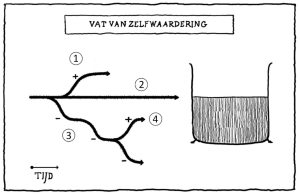The barrel of self-esteem is a psychological model for behavioural change. You can use this, for example, if you want to be happier with yourself, be more active or productive, suffer less from negative habits or experience more control and peace. The model assumes that the ability to solve your own problems depends on the amount of self-esteem you have. Two things are central within this model: the barrel and the switches.
The barrel
The barrel is a metaphor in which self-esteem is the liquid that ‘fills’ the barrel . The whole barrel symbolises everything that makes you a person: your thoughts, knowledge, memories, insecurities, character and so on. Within the barrel two parts can be distinguished: the full part (self-esteem) and the empty part (emptiness).
Self-esteem stands for everything that has a positive meaning or experience. Something you can enjoy, something you are proud of or something that gives you a boost. Emptiness is the exact opposite; it is the negative memories, bad habits, traumas, our shortcomings and the things we miss. With a barrel that is mostly filled with self-esteem, you’ll be more likely to get out of the right side of the bed and be less likely to suffer from all the elements of emptiness. With a barrel that’s more empty, you will experience everything a lot more negatively.

The switches
The (train) switches are a metaphor for the effect of an experience on your self-esteem. In other words, has something you have done or experienced had a positive or negative effect? Such an experience can have an effect in four different ways:
- The positive switch: These are all pleasant moments of satisfaction. A brief moment of awareness in which you notice that something is good. Think of a nice cup of coffee, a compliment from your boss or a nice thought. A positive switch has a small strengthening effect on your self-esteem and thus fills your barrel with a little bit of self-esteem.
- The autopilot: This is where 99% of everything you do takes place. Humans have evolved to perform tasks effortlessly without thinking about it. Think of driving a car or walking. Because it takes place outside your attention, it has no effect on your self-esteem and therefore does not fill your barrel.
- The negative switch: Everything that is triggered by a stress reaction ends up on this switch. Forgetting something, being criticised, an argument, a traumatic memory. Because it is stress-related, it catches your attention. This switch reinforces itself because we often react to stress with intensity. As a result, stress increases. A well-known example is the angry road abuser from TV: someone is accidentally cut off, swears, starts driving faster, raises a fist, drives through a red light and also abuses the police when he is apprehended. With each additional step, the self-esteem drains from your barrel little by little.
- The (recovering) positive switch: This is the most difficult switch. This switch harvests self-esteem after a stressful event. For example, this is the self-control you apply when you realise that you’re only hurting yourself for getting angry over something petty. Because observing this can be seen as a successful experience, which positively affects your self-esteem.
Observe with attention
The starting point of this model is that it is important to learn to observe all of the above. The negative switches will always be there because our biological stress system is designed to respond automatically to stimuli. The trick is to start practising observing everything you do and experience in order to fill your barrel with self-esteem. You can do this through the following two observation exercises:
- Try to observe 3 positive changes every day and physically or mentally pat yourself on the back in combination with the words: “Good that I noticed!”. The trick is in finding the smallest things. Is it something you are satisfied with? Then it already counts!
- Once you have mastered the 1st exercise a bit, you can start practising perceiving the negative switches. Again, the same applies. Pat yourself on the back with “Good that I noticed!”. The goal is not to feel different in the situation, but to learn to think about what is happening and to ask yourself whether it gives you satisfaction. If you keep applying this, you will eventually react with less intensity to the same stressful situations.











